General
We published a photograph in the “Code Violations” section of the March/April 1995 IAEI News which shows 21 service disconnecting means that are grouped in the same location on the end of an apartment building. Four service laterals supply the building from a common transformer. The caption with the photograph indicates that the installation is in violation of Section 230-71(a) of the National Electrical Code® as there are more than six disconnects grouped at the same location.
After getting a few phone calls asking for clarification of the Code requirements as well as three letters indicating disagreement with our conclusion, we published a Closer Look article on services for multiple-occupancy buildings in our July/August 1995 IAEI News. The article was based on the rules in the 1993 NEC®.
We decided to take another look at these requirements since several changes have taken place in Code rules since that time. Some key definitions of terms used in Article 230 have changed as well. Where used in this article from this point on, terms that are defined in Article 100 are in italics. That is just to help remind us that these terms have precise meanings as used in the NEC®. As is true with many discussions of subjects related to any code, it is important to have a good understanding of definitions that apply to the installation under consideration. These terms have a specific meaning where used in the Code.
We will take a brief tour through some of the basic requirements in the Code that apply to the installation as well as review the applicable definitions. This discussion is based on the 1999 National Electrical Code®.
General Requirements
Section 230-2 has had a change of format as well as been rewritten to change the previous exceptions into positive language. There is now a general rule that requires, “A building or other structure served shall be supplied by only one service unless permitted in (a) through (d).” These subsections contain six of the former seven exceptions to the general rule. Language identical or similar to this has been in many editions of the Code. For the purpose of our discussion, we will assume that the multifamily dwelling under consideration does not have a fire wall that would qualify as a building separation as mentioned in Article 100. In addition, we will not cover Section 230-2(a) Special Conditions (applies to installations of services for fire pumps, emergency systems, etc.) or Section 230-2(d) Different Characteristics, as multifamily dwellings are generally supplied at one voltage level and system type.
Some Definitions
As an aid to the reader, we have underlined new words added to the definitions since the 1996 NEC® and struck through words that are deleted. The definition of “service” has been revised in the 1999 NEC® and is now defined in Article 100 as, “The conductors and equipment for delivering electric energy from the serving utility electricity supply system to the wiring system of the premises served.” These changes clarify that on-site power production such as solar photovoltaic systems, generators and power production facilities such as cogeneration systems are usually separately derived systems and not services. The term “service” is a broad term that includes the service drop, service lateral, service-entrance conductors (both overhead and underground system) and service equipment which includes the service disconnecting means. Of course, the definition of “equipment” is also a very broad general term that includes “material, fittings, devices, appliances, fixtures, apparatus, and the like used as a part of, or in connection with, an electrical installation.”
The term “service equipment” has also been revised in the 1999 NEC® and is now defined in Article 100 as, “The necessary equipment, usually consisting of a circuit breaker(s) or switch(es) and fuse(s), and their accessories, connected to the load end of service located near the point of entrance of supply conductors to a building or other structure, or an otherwise designated defined area, and intended to constitute the main control and means of cutoff of the supply.” As can be seen, the term “service equipment” includes the equipment, such as switches and fuses as well as circuit breakers, that are used as the “service disconnecting means.”
The term “service disconnecting means” is not defined in the NEC®, although the term is used in several articles including the definition of “service conductors” in Article 100. Section 230-70 contains several requirements for the service disconnecting means and also describes its purpose. The service disconnecting means is or are provided to “disconnect all conductors in a building or other structure from the service-entrance conductors.” It must be located “at a readily accessible location either outside of a building or structure or inside nearest the point of entrance of the service conductors.” Each service disconnecting means must be permanently marked to identify it as a service disconnecting means and must be suitable for the prevailing conditions, such as being suitable for a wet location.
The term “building” is defined in Article 100 as, “A structure that stands alone or that is cut off from adjoining structures by fire walls with all openings therein protected by approved fire doors.” The term “structure” is not defined in the Code although Section 230-21 mentions “such as a pole” when describing an “other structure.” Since the term is not defined in the Code, we can use a common dictionary definition such as “Something made up of a number of parts held or put together in a specific way.” So, we can apply the rules for installation of service equipment to any building or structure the service equipment is mounted in or on.
The term “service conductors” has also been revised in the 1999 NEC® and now is defined in Article 100 as “The supply conductors that extend from the service point street main or from transformers to the wiring system service equipment of the premises supplied.” The term “service conductors” is a broad term that includes: “service drop,” “service-entrance conductors, overhead system,” “service-entrance conductors, underground system” and “service lateral.” This change coordinates with Section 90-2(b)(5) which indicates that installations under the exclusive control of electric utilities for distribution of electric energy are not covered by the Code. However, these same conductors installed by the owner, contractor or electrician are covered by the Code.
As can be seen, the conductors supplied by an electric utility on the line side of the “service point” are now not considered by the Code to be “service conductors.” The term “service point” is defined in Article 100 as, “The point of connection between the facilities of the serving utility and the premises wiring.” This means that where the service point is at the building or structure such as the connection at the weatherhead for overhead services or at the meter socket for underground services, the service drop and service lateral are not covered by the Code.
The following definitions also apply to our discussion and should be understood:
“Service Drop: The overhead service conductors from the last pole or other aerial support to and including the splices, if any, connecting to the service-entrance conductors at the building or other structure.”
“Service-Entrance Conductors, Overhead System: The service conductors between the terminals of the service equipment and a point usually outside the building, clear of building walls, where joined by tap or splice to the service drop.”
“Service-Entrance Conductors, Underground System: The service conductors between the terminals of the service equipment and the point of connection to the service lateral.
(FPN): Where service equipment is located outside the building walls, there may be no service-entrance conductors, or they may be entirely outside the building.”
“Service Lateral: The underground service conductors between the street main, including any risers at a pole or other structure or from transformers, and the first point of connection to the service-entrance conductors in a terminal box or meter or other enclosure with adequate space, inside or outside the building wall. Where there is no terminal box, meter, or other enclosure with adequate space, the point of connection shall be considered to be the point of entrance of the service conductors into the building.”
Section 230-2
With these definitions in mind, let’s look at the requirements in Section 230-2 for installing a service for a multiple-occupancy building. The general rule in this section is that “A building or other structure shall be supplied by only one service unless permitted in (a) through (d).” Keep in mind that the term “service” includes, “The conductors and equipment for delivering electric energy from the serving utility to the wiring system of the premises served.”
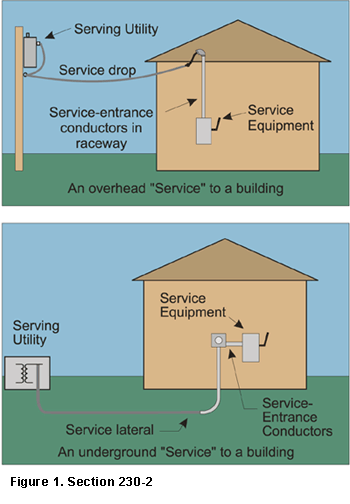
The general requirement is that only one service drop or service lateral is permitted to be run to a building or other structure where the service equipment is located. Why? Because the term “service” includes both the “service drop” and “service lateral” and Section 230-2 generally permits only one service to a building or structure. The service drop will connect to service-entrance conductors, usually “outside the building, clear of building walls.” (See the definition in Article 100.) As can be seen in the definition of “service lateral,” where the service lateral stays outside the building such as supplying weatherproof service equipment, there are no service-entrance conductors.
Structure with a Fire Wall
A structure with a fire wall that qualifies as a building separation is considered to be more than one building as determined by the number of fire-wall separations. For example, a structure with one fire wall will be two buildings. The fire resistance rating of a fire wall required to qualify as a building separation is not given in the NEC®. It is necessary to obtain the details on fire-wall construction to create a building separation from the applicable building code. Usually, a fire wall having not less that a two-hour rating is required to create a building separation. Each of these buildings is then generally permitted to have not more than one service to it. Have you seen a duplex (two-family dwelling) with two service drops or service laterals to it? This is a violation of Section 230-2 unless the structure has a qualifying fire wall.
A permanent plaque or directory is required where more than one service is permitted for any reason, be it fire-wall separation or one of the conditions of Section 230-2(a) through (d). This requirement applies where a building or structure is supplied by any combination of more than one service, feeder or branch circuit. The plaque or directory must be located at each service disconnect location and must indicate all other services, feeders or branch circuits supplying that building or structure and give the area served by each of them. See Section 230-2(e).
Section 230-2(b) Special Occupancies
(This previously was Section 230-2 Exception No. 3, Multiple-Occupancy Buildings.) This subsection permits additional services, by special permission, for (1) Multiple-occupancy buildings where there is no space for service equipment accessible to all occupants, and for (2) A single building or other structure sufficiently large to make two or more services necessary.
The term “multiple-occupancy building” is not defined in the NEC® but “multifamily dwelling” is. Traditionally, the term multifamily dwelling has been interpreted as a multiple-occupancy building in applying the rules of the NEC®. Building codes tend to use the term “occupancy” as referring to a class of users of a building such as “business use,” “educational use” or “residential use.” So, a multiple-occupancy building in building code terms would have more than one type of occupancy in the same building and might be referred to as a “mixed use or occupancy” building. The NEC® tends to use the phrase “multiple-occupancy building” as one having more than one occupant rather than more than one class of occupant.
Figure 2. Section 230-2(b)(1).
Section 230-2(b)(1)
Note that Section 230-2(b)(1) permits an additional service(s) where there is “no available space for service equipment,” that is “accessible to all the occupants.” It seems there will always be space available for a single main disconnecting means, or up to six disconnecting means grouped at one location that is be accessible to all the occupants. This service equipment does not have to be inside such as in an electrical equipment room but can be located outside on or adjacent to the building. The location rule is in Section 230-70(a) and reads, “The service disconnecting means shall be installed at readily accessible location either outside of a building or structure or inside nearest the point of entrance of the service conductors.” Economical design criteria may dictate not installing a single main service disconnecting means but that consideration is not given in this Code rule. In addition, there may not be space at one location for all the metering equipment and individual meter/mains needed for a large complex. However, this section does not address multi-metering or feeder disconnecting means for all the individual occupancies. The installation in the photograph at the beginning of this article fails the test for this subsection as there certainly appears to be space at the location chosen for the multiple services for a single service to be installed with meter/feeder supply to the individual dwelling units.
There is no requirement in this rule that the space available for the service equipment that is to be accessible to all the occupants must be inside the building. It is quite common to locate service equipment outside multiple-occupancy buildings as indicated in the photograph that accompanies this article. If there is space for the service equipment in a common area, including outside, that is adequate for the service equipment for the building, Section 230-2(b)(1) cannot be used. If space is available for the service equipment to serve all the occupancies, then, according to the main rule, only one service is permitted for the building with a maximum of six disconnects. (We will look at some other provisions a little later in this article.)
Where the main disconnecting means is or are located before the metering equipment, it is common for the serving utility to require that the service disconnecting means enclosure be locked to reduce the likelihood of tampering and theft of electrical energy. The authorization for more than one service in Section 230-2(b) must be by “special permission,” which is defined in Article 100 as “The written consent of the authority having jurisdiction.”
It is not necessary for there to be a fire wall separation to grant the “special permission” provided for in this subsection. As provided in Section 230-2(b), “special permission” is to be based on space-for-equipment considerations. Six service disconnecting means are permitted to be installed for each additional service that is allowed by the authority having jurisdiction under Section 230-2(b)(1). The Code does not clearly require that the additional services installed as permitted by this subsection be installed at a location separate from the other service(s) to the building. For example, a building is supplied by a 120/240 volt, single-phase service with six service disconnecting means grouped at one location. A second service, this one a 208Y/120 volt, three-phase service, can be installed immediately adjacent to the single-phase service with an additional six service disconnecting means. See Section 230-71(a).
Section 230-2(b)(2)
(This previously was Section 230-2 Exception No. 5, Buildings of Large Area.) Again, by special permission, one or more additional services are permitted for “A single building or other structure sufficiently large to make two or more services necessary.”
No guidance on how to determine what qualifies as a “building of large area” is provided in the NEC®. Large industrial plants where lengthy feeder runs would cause excessive voltage drop which would require increasing the conductor size unreasonably is an example of where this exception may be applied. Other examples are large shopping centers or high-rise office buildings. The authority having jurisdiction is pretty much left on his own when attempting to determine when to allow this subsection to be applied.
Obviously, this subsection does not apply to the installation under review as there are no long feeder runs involved.
Section 230-2(c). Capacity Requirements
(This subsection is the former Exception No. 4 to Section 230-2.) This subsection permits additional services to a building or other structure for only the following reasons, all of which are related to the capacity or size of the service:
“(1). Where the capacity requirements are in excess of 2000 amperes at a supply voltage of 600 volts or less; or
(2). Where the load requirements of a single-phase installation are greater than the serving agency normally supplies through one service; or
(3). By special permission.”

Condition “(1)” does not apply to this installation as there is no service in excess of 2000 amperes. The total ampacity of the four service laterals do not come close to 2000 amperes. In fact, the size of the four service laterals could no doubt be smaller if they were combined to serve all the loads. This is due to the increased demand factors permitted by Article 220 for load calculations as the number of units served increases.
One disadvantage of installing the service lateral conductors in parallel (connected together at both ends to form a larger conductor) is the fault current available at the service equipment will be greater than where individual sets of conductors are run to separate service equipment enclosures.
Condition “(2)” does not apply as the four service laterals shown in the photograph are from the same transformer and thus obviously do not exceed the capacity of the serving utility’s transformer.
Condition “(3)” provides for special permission from the authority having jurisdiction. To apply in this situation, the special permission must relate to the capacity of the system. Condition “(3)” does not seem to apply to the installation under review as there is no need for an additional service based on capacity considerations. The single transformer installed by the utility has adequate capacity for the load.
Sections 230-2 and 230-40 Exception No. 2
Former Exception No. 7 to Section 230-2 has been incorporated into the opening paragraph of Section 230-2 as a new second sentence. The sentence reads, “For the purpose of Section 230-40, Exception No. 2 only, underground sets of conductors, size 1/0 and larger, running to the same location and connected together at their supply end but not connected together at their load end shall be considered to be supplying one service.” This sentence really does not allow an additional service in the strictest sense but allows several sets of service lateral conductors to be considered as supplying one service. (In reality, the service lateral does not supply the service but is a part of the service as defined in Article 100.)
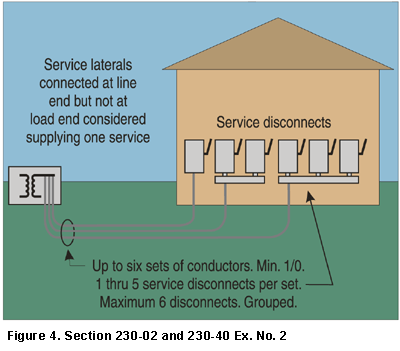
As indicated, the second sentence of Section 230-2 is limited in application to Section 230-40 Exception No. 2. It reads, “Where two to six service disconnecting means in separate enclosures are grouped at one location and supply separate loads from one service drop or lateral, one set of service-entrance conductors shall be permitted to supply each or several such service equipment enclosures.”
As illustrated in Figure 4, a maximum of six service laterals, sized 1/0 or larger, that are connected together at their line end, but not at their load end, are considered to be supplying one service. The service laterals must be run to a common location at the building or structure served and are permitted to supply one, two or up to a total of six service disconnecting means. However, no more than six disconnecting means are permitted to be grouped at the location being served by these service laterals. See Section 230-71(a).
Section 230-40 Exception No. 1
Section 230-40 generally permits a service drop or service lateral to supply not more than one set of service-entrance conductors. When taken with the requirements of Section 230-2 and the definition of “service” in Article 100, this means that a building or other structure can generally be supplied by only one service drop that connects to one set of service-entrance conductors or it can be supplied by one service lateral that connects to one set of service-entrance conductors.
Exception No. 1 to Section 230-40 provides that, “Buildings with one or more than one occupancy shall be permitted to have one set of service-entrance conductors for each class of service run to each occupancy or group of occupancies.”
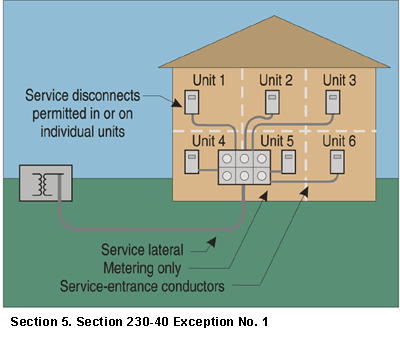
Figure 5 illustrates an underground supply to a multiple-occupancy building. A similar procedure can be followed for an overhead supply. While only six units are shown due to space limitations, any number of units may be served in a similar manner.
The service lateral supplies a metering cabinet that does not contain service disconnecting means or overcurrent protection but has only meter sockets. A set of service-entrance conductors is run to each occupancy or to a group of occupancies. Of course, these service-entrance conductors do not have overload protection until they terminate in the service equipment. Where this scheme is selected, it is customary to run service-entrance conductors to the individual units rather than to a group of units. Up to six disconnecting means are permitted in or on each of the units, and of course, they must be grouped at the individual locations to comply with Section 230-71 (a).
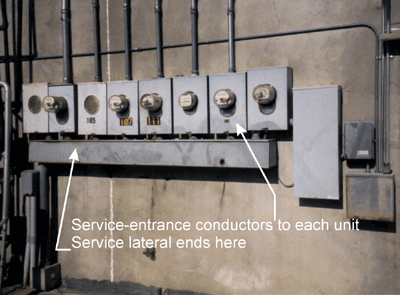
As indicated in the Figure 6, service lateral conductors are run from the utility transformer to a wireway mounted below the meter sockets. Service-entrance conductors are spliced to the service lateral conductors within the wireway and run through the meter sockets to each unit. Service disconnecting means and overload protection is provided in or on each unit.
The location of the service disconnecting means must comply with Section 230-70 (a) which requires, “The service disconnecting means shall be installed at a readily accessible location, either outside of a building or structure or inside nearest the point of entrance of the service conductors.” Some inspection jurisdictions interpret, “nearest the point of entrance of the service conductors” to require the service equipment to be located in the stud space in the outside wall or back-to-back with the meter socket or point of entrance. Others interpret this rule to permit up to four feet of service-entrance conductors inside the building, while still others permit as much as 25 feet of service-entrance conductors to be installed inside the building. In some cases where these longer lengths of service-entrance conductors are permitted inside the building by local rule, a limited number of wiring methods are permitted. Be certain to verify the local rule or interpretation before beginning an installation.
Section 230-71(a)
This section provides that, “The service disconnecting means for each service permitted by Section 230-2, or for each set of service-entrance conductors permitted by Section 230-40, Exception Nos. 1 or 3, shall consist of not more than six switches or six circuit breakers mounted in a single enclosure, in a group of separate enclosures, or in or on a switchboard. There shall be no more than six disconnects per service grouped in any one location.” Since the term “location” is not defined in the Code, it will be applied based on its common dictionary meaning. As this word applies to the installation in the first photograph, most people probably would apply the meaning of “location” to be that all the service disconnects shown are at the same “location” since they are immediately adjacent to each other at the same end of the building. Most people would likely consider the services to be in different “locations” if a service were installed some significant distance apart such as at opposite ends of the building.
As we previously mentioned, more than six service disconnects are permitted at the same location only where more than one service is permitted to a building. For the installation under consideration, it does not appear that any of the rules in Section 230-2(a) through (d) apply so only one service with a maximum of six disconnecting means is permitted.
Section 230-72
This section generally requires the service disconnecting means permitted by Section 230-71 to be grouped.
In a multiple-occupancy building, each occupant is required to have access to their service disconnecting means. The exception to Section 230-72(c) allows the service disconnecting means that supplies more than one occupancy to be accessible to authorized building management personnel only where the electric service and electrical maintenance for the building are under continuous building management supervision. This exception does not apply to the multiple-occupancy installation under consideration as all the service disconnecting means are on the outside at a common location and are accessible to each of the occupants.
Conclusion
As can be seen, there are many different ways to install the service for a multiple-occupancy building and be in compliance with the National Electrical Code. To do so requires a thorough reading and understanding of the definitions and Code requirements that apply. As you have probably observed, the installation shown in the photograph at the beginning of this article did not comply with the 1993 or 1996 NEC and would not comply with the revised rules of the 1999 NEC Article 230.
Serving utilities may have local requirements regarding serving multiple-occupancy buildings that must be complied with. These utilities often have booklets with diagrams that illustrate their distribution requirements.
Finally, the authority having jurisdiction may have local amendments to the Code that must also be complied with as well. These amendments will be in the form of legally adopted ordinances, regulations or statutes and are not simply an unwritten interpretation. These local amendments, if any, are also available in writing from the inspection agency.

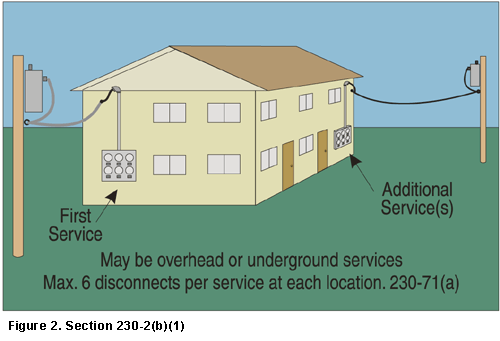









Find Us on Socials